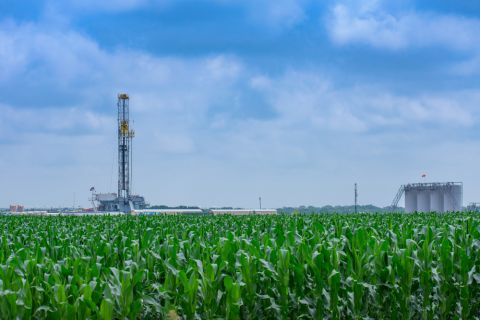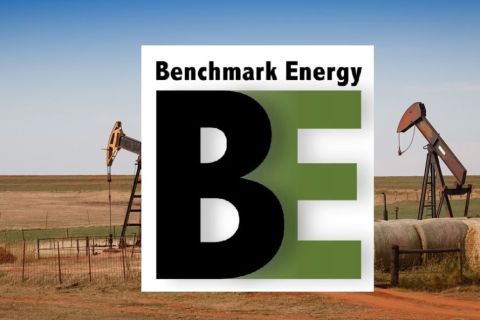Because a direct examination of the wellbore construction environment isn’t possible, the wellbore designer must use indirect measurements such as seismic images and velocities along with correlations from nearby well bores. Therein lies the source of subsurface uncertainty.
To further refine the subsurface model and reduce the remaining uncertainties of indirect measurement, well planners can use stochastic modeling to arrive at a range and likelihood of subsurface possibilities through a mathematical process of quantifying and understanding risk.
Well design inputs
The two primary inputs for effective wellbore design are an understanding of the 3-D
 |
|
| Figure 1. Well/seismic correlation parameters. (Images courtesy of Knowledge Systems) |
With them, a proper well design can be developed to minimize or prevent formation fluid influx (kicks), drilling fluid losses and wellbore instability. A 10-year study of drilling non-productive time (NPT) by James K. Dodson Co., observed that 44% of lost time could be attributed to these pressure- and stress-related construction hazards.
Wells are often designed using a deterministic approach to subsurface modeling that leaves the planner unaware of all the possibilities and their likelihood. Traditional correlations often use a single nearby well bore which is assumed to be representative of the new target. With inferential statistics used in stochastic modeling, conclusions can be drawn about the target location parameters using many more variables. By combining an array of known parameters, ranges and distributions into a Monte Carlo simulation, the well planner can calculate the range and probability of each value along the wellbore trajectory.
Clarifying uncertainties
In a typical planning scenario, a new subsurface target is identified and nearby analogue wellbore information is collected, aggregated and correlated across the region. Seismic data is frequently available and provides a valuable source of information between the control wells.
This analogue wellbore and seismic data is used to build a predictive model of in-situ Earth stress and pore pressure at the target location. To do this, relationships between seismic interval velocities and other properties must be developed and calibrated at each analogue well bore. A traditional arrangement in the Gulf of Mexico’s Mississippi Canyon might have five analogue wells, one target well and seismic coverage.
In this process, each analogue well is studied and relationships are established for velocity-Rhob, velocity-s v (effective stress) correlations as well as a near-mud line density correlation. Figure 1 shows the wells and correlation parameters for each variable.
As the figure shows, the parameters controlling the Miller near-mud line density correlation
 |
|
| Figure 2. Pore pressure simulations at specific depths. |
Because the geology is not uniform, you can’t assume the well bore closest to the target is the most significant. In this case, all five well bores were predicted to be equally significant geologically. From this, we can conclude that there are uncertainties in the prediction modeling parameters which must be mathematically considered when making the prediction.
The other primary source of prediction uncertainty comes from seismic interval velocities.
Unlike a sonic log acquired directly from the well bore, seismic waves travel in a hyperbolic route in which several gathers actually cross through each wellbore trajectory. Because we can not perfectly distinguish which pieces of each gather go to the well bore, it is considered an industry best practice to collect a section of gathers surrounding the well bore.
Modeled predictions
Having collected all of the relevant data and identified the sources of significant uncertainty, a modeled prediction is made at the target location. Each variable that will be subjected to the Monte Carlo simulation must have several constraints, including population distribution (normal, triangular, rectangular, etc.) and minimum, maximum, mean and confidence interval. Typically, each depth slice receives 1,000 to 5,000 simulations in order to construct the population from which the sample inference can be made.
The primary input to the gravitational loading model for the Earth-stress tensor is overburden. It is calculated using near-mud line density correlation with the Gardner velocity/density transform applied to the seismic velocities. The overburden simulation results, used in the subsequent analysis, made it clear that despite significant well control and tight gathers, there was substantial uncertainty left to be considered in the wellbore design.
If we look at pore pressure predictions from the Monte Carlo simulations of Bowers’ models in Figure 2, we can see the variance in simulated distribution as a function of depth. This is largely due to anchoring of the normal pressure at the mud line and the tendency of uncertainty to accumulate with well depth.
Figure 2 also shows the kind of distribution density achieved when using a thousand simulations per depth slice. Clearly, more simulations would produce a smoother distribution, but for the purposes of simulation, run times and 5-ft (1.5-m) depth increments provide adequate model granularity. A key consideration in building uncertainty models is granularity. Sensitivity analysis in the form of tornado charts can be useful mathematical approaches; however, there is no substitute for the knowledge of subject-matter experts when selecting modeling parameters.
Aggregating results from the overburden, pore pressure and fracture gradient simulation
 |
|
| Figure 3. P10 and P90 simulations and modeled casing programs. |
Examples of 10% probability (P10) and 90% probability (P90) are shown in Figure 3, along with casing plans designed on these safe operating windows plus a small safety margin. In the P10 example, odds are that 10 wells in a hundred will be constructed using only three sets of casing. In the P90 example, the well bore can be constructed 90% of the time with six casing strings.
These uncertainties will drastically affect the well cost possibilities and the economic feasibility of the prospect. But because they represent genuine subsurface uncertainty remaining after rigorous analysis, they must be considered in creation of a wellbore design that is consistent with the risk tolerance of the well planner and operator.
Of course, the P50 could be chosen because it is the most likely occurrence in a normally distributed system. Unfortunately, designing based on the P50 probability means half the well bores will be under-designed, exposing construction operations to safety and environmental concerns in addition to unwanted non-productive time. In the other half of the cases, the well bore will be over-designed and possibly have too much AFE allocated.
In cases where risk tolerance is very low, a higher probability should be chosen; in cases where risk tolerance is high, a lower probability can be chosen. For example, where poor logistics are a concern, it would be prudent to over-design based on a P90 case, rather than not have enough steel to finish the well. Where logistics are good, a leaner program may be sufficient.
Biasing information
Stochastic modeling is an accepted mathematical approach for quantifying and understanding risk. It does not necessarily provide tangible answers to well design problems, but it does give the well planner biasing information which can be applied to the design process.
Company policy, government regulations and material availability are additional factors that must be considered when using this technique and selecting the optimal wellbore design. Risk is certainly present; making a reasonable attempt to quantify and incorporate it into well planning can improve safety and efficiency and extend wellbore life.
Recommended Reading
Chevron CEO: Permian, D-J Basin Production Fuels US Output Growth
2024-04-29 - Chevron continues to prioritize Permian Basin investment for new production and is seeing D-J Basin growth after closing its $6.3 billion acquisition of PDC Energy last year, CEO Mike Wirth said.
Novo II Reloads, Aims for Delaware Deals After $1.5B Exit Last Year
2024-04-24 - After Novo I sold its Delaware Basin position for $1.5 billion last year, Novo Oil & Gas II is reloading with EnCap backing and aiming for more Delaware deals.
Enverus: 1Q Upstream Deals Hit $51B, but Consolidation is Slowing
2024-04-23 - Oil and gas dealmaking continued at a high clip in the first quarter, especially in the Permian Basin. But a thinning list of potential takeout targets, and an invigorated Federal Trade Commission, are chilling the red-hot M&A market.
EIA: Permian, Bakken Associated Gas Growth Pressures NatGas Producers
2024-04-18 - Near-record associated gas volumes from U.S. oil basins continue to put pressure on dry gas producers, which are curtailing output and cutting rigs.
Benchmark Closes Anadarko Deal, Hunts for More M&A
2024-04-17 - Benchmark Energy II closed a $145 million acquisition of western Anadarko Basin assets—and the company is hunting for more low-decline, mature assets to acquire.





